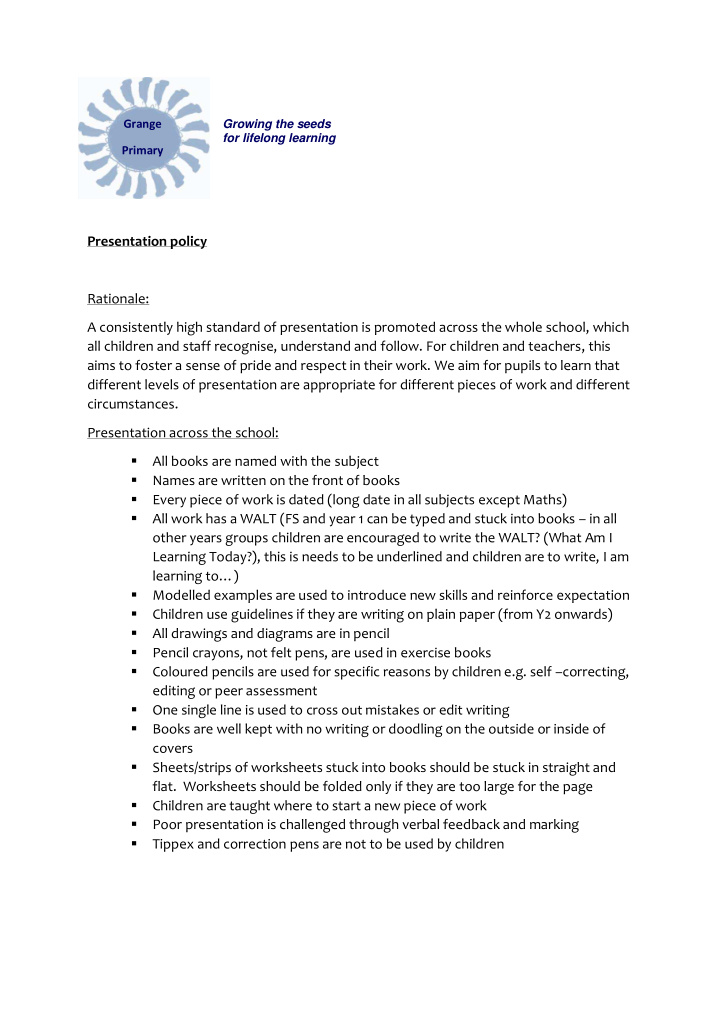



Grange Growing the seeds for lifelong learning Primary Presentation policy Rationale: A consistently high standard of presentation is promoted across the whole school, which all children and staff recognise, understand and follow. For children and teachers, this aims to foster a sense of pride and respect in their work. We aim for pupils to learn that different levels of presentation are appropriate for different pieces of work and different circumstances. Presentation across the school: All books are named with the subject Names are written on the front of books Every piece of work is dated (long date in all subjects except Maths) All work has a WALT (FS and year 1 can be typed and stuck into books – in all other years groups children are encouraged to write the WALT? (What Am I Learning Today?), this is needs to be underlined and children are to write, I am learning to…) Modelled examples are used to introduce new skills and reinforce expectation Children use guidelines if they are writing on plain paper (from Y2 onwards) All drawings and diagrams are in pencil Pencil crayons, not felt pens, are used in exercise books Coloured pencils are used for specific reasons by children e.g. self – correcting, editing or peer assessment One single line is used to cross out mistakes or edit writing Books are well kept with no writing or doodling on the outside or inside of covers Sheets/strips of worksheets stuck into books should be stuck in straight and flat. Worksheets should be folded only if they are too large for the page Children are taught where to start a new piece of work Poor presentation is challenged through verbal feedback and marking Tippex and correction pens are not to be used by children
Presentation protocol: FS Year 1 Year 2 Year 3&4 Year 5&6 Writing A selection of A selection of Fine Introduce Once implements ‘beginners’ ‘beginners’ pencils handwriting handwriting thick and fine thick and fine pens (blue) is neat and writing writing as joined, implements. implements. appropriate pupils Chunky Chunky for Literacy should be triangular triangular and written using pencils are pencils are work. Pencil handwriting introduced introduced. for Maths pens for Thin work. Black written triangular handwriting work. pencils with pen is used Pencils for grips then for editing. maths. fine pencils with grips for most pupils Felt tips should not be used where they will come through onto the reverse of the paper in books. Self- Simple, straight line through to show Simple, straight line correction where they have self - corrected through to show where they have self - corrected. Eraser or correction fluid may be used at the discretion of the teacher for final draft work. Ruler use All straight lines to be drawn with a ruler. Younger pupils will need to be taught how to do this. Bar models should be drawn without a ruler. New work New work to All work to be dated by All written work to be commence child or teacher at top, dated by child, at top, right on a new right side. hand side using full date, page. and underlined. Maths to All work to use numbered date e.g. be dated by 25/09/17 an adult. Paper To use Teachers should select Narrow lines and small unlined paper lined paper, appropriate squared exercise books. for the to the size of writing, so majority of that pupils can position the time in writing correctly on the Nursery. line. Wide lines and large To use lined squared exercise books paper for the for some pupils at teacher majority of discretion. the time in Reception.
Recommend
More recommend